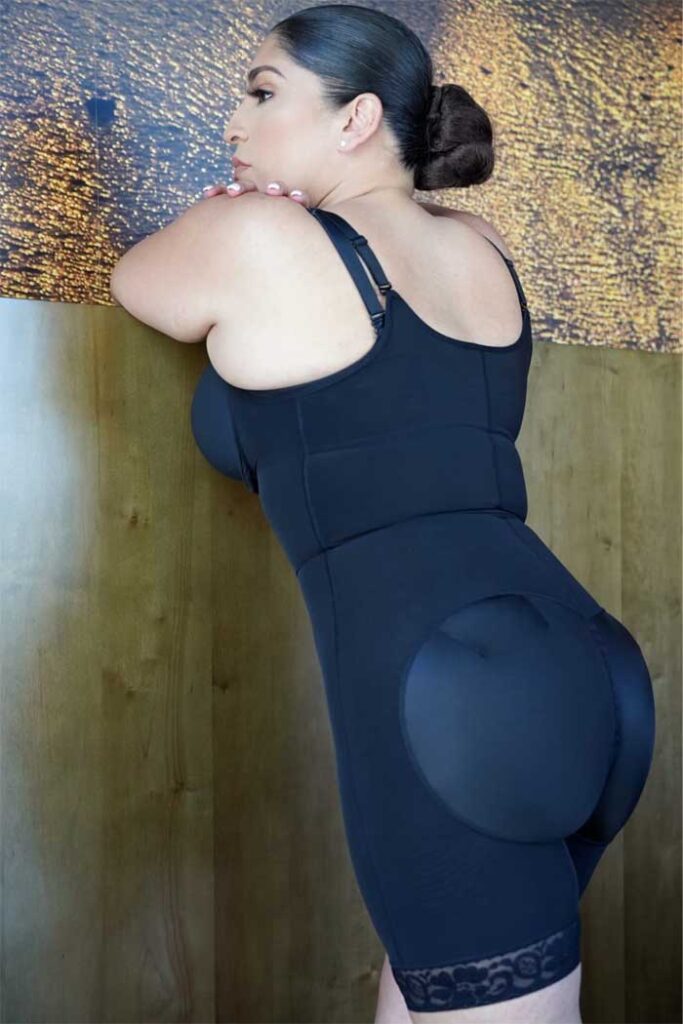Wearing a compression garment after plastic surgery has been shown to hasten the healing process. Compression garments made by us are of medical grade, so they prevent lymphedema and keep wounds from being irritated.
While healing, a surgical compression garment can help alleviate any discomfort that may arise. You can browse our compression garments by procedure to find the ones that best fit your needs.
Why wearing compression garments after Liposuction surgery is important to aid recovery and ensure the best results?
The tight socks worn by marathon runners are just one example of a type of compression clothing. If you want the finest possible outcomes from your liposuction procedure, you need this high-tech, advanced recovery gear to help you recover faster. One of the best ways to improve the results of your liposuction procedure is to wear compression garments as directed following surgery.
If you don’t wear compression clothing, you can experience more bruising and swelling, loose skin, and wrinkles.
Take Charge of Your Health with The Home Doctor
Discover real-world remedies and first-aid solutions you can use when help isn’t around.
👉 Claim Your Home Doctor GuideWhen it fits properly, there shouldn’t be any discomfort. Your doctor may recommend ordering many sizes so that you can gradually decrease the pressure when the swelling goes down.
Wearing compression clothing during recuperation can help with both comfort as well as speed up the healing process by decreasing swelling and bruising. In particular, they enhance the results of your liposuction by facilitating the body’s adaptation to its new contour.
Compression garments, if used correctly during liposuction recovery, can:
- Lower the Fluid Level
After liposuction, your body will create fluids that might accumulate and become stagnant, resulting in unsightly swelling. Compression garments reduce swelling after surgery by preventing fluid buildup by uniformly providing pressure to the area.
- Protect your skin from bruising
Bruising is the consequence of blood rising to the surface of the skin after being pushed back down after being traumatized by liposuction on the blood vessels just under the skin. When worn, compression clothing helps keep blood from pooling on the skin’s surface, reducing the severity of bruising.
- Reduce Scarring
When performed properly, liposuction rarely leaves noticeable scars because the incisions are so tiny and discreet. However, compression garments aid in further reducing scarring by maintaining pressure on the incision site. This results in flatter, smoother skin.

- Avoid the Formation of Swelling (Edema)
Liposuction involves the removal of subcutaneous and supramolecular fat, which leaves a cavity in which fluid can collect. Edema refers to the buildup of fluid in this area, which leads to swelling and bumps. By applying pressure to the skin and muscles, compression garments reduce this gap and so reduce the risk of fluid collection.
- Reducing Pain or Discomfort
Compression garments are helpful for many post-operative patients, as they provide a sense of security and make early recovery from surgery simpler to navigate. Wearing compression garments after a liposuction surgery has been shown to lessen pain, improve posture, and increase attentiveness to the affected area.
Go see your doctor for a better-fitting compression garment if your current one is causing more discomfort than relief.
- Boost the Overall Outcome
Wearing compression garments may not be glamorous, but they will improve your performance. With this supportive compression, your skin won’t sag or wrinkle, and you’ll see a tighter, more defined silhouette in no time.
What Are The Procedures That Need Compression Garments?
If you want to heal more quickly after surgery, your doctor may recommend wearing a surgical compression garment.
- Tummy tuck surgery
Tummy tucks, also known as abdominoplasty, are a common cosmetic operation that removes extra skin and fat from the abdominal area. It aids in strengthening the slackened muscles, and it helps the stomach area become flatter and firmer.
- BBL
A Brazilian butt-lift is a surgical procedure that uses liposuction to remove fat from other areas of the body and move it to the buttocks. Following a BBL treatment, a compression garment might help you recover more quickly.
- Breast augmentation surgery
Breast augmentation, medically called augmentation mammoplasty, entails inserting either silicone or saline implants beneath the breast tissue to enhance the breasts’ size, firmness, and contour. Wearing compression clothing after getting breast implants aids in keeping the implants in place during the healing period.
- Breast lift surgery
Lifting, tightening, and reshaping the breast is possible through a surgical procedure called mastopexy. In addition, It can alter or diminish the size of the areolas (the circle around the nipples). Compression garment use after a breast lift is essential for a speedy recovery.
- Gynecomastia
Gynecomastia occurs when there is an excess of estrogen in the body and a deficiency of testosterone, leading to the development of abnormally large breast tissue in males. The condition is treatable with gynecomastia surgery, which involves reducing the size of the breast tissue in men. One of the most important aspects of recovering quickly from gynecomastia surgery is wearing a compression garment.
- Liposuction
After liposuction, wearing a compression garment can help reduce edema and speed recovery. Moreover, the garment’s compression after liposuction helps move the fluid that has gathered under the skin to the surface, reducing the visibility of any lumps or bumps that may have formed.
How Long Should Compression Garments Be Worn?
- Your surgeon or specialist will recommend the appropriate compression garment to wear after surgery. Your surgeon will consider your specific procedure when deciding which compression garment is best for you.
- Find out from your doctor how long you should wear a compression garment, although, in most situations, it’s at least a month.
- You must wear your compression garment at all times, including when sleeping, with the exception of bathing. Consequently, you should purchase two or more surgical compression garments so that you always have a clean one on hand.
How To Take Care Of Your Post Compression Garment?
Daily washing of your compression garment eliminates dirt and sweat, which helps it retain its suppleness.
- Hand washing – Hand wash your compression garment in warm water with a mild detergent and line dry in the sun.
- Washing Machine – If you need to wash your compression garment, do it in the washing machine, but use the gentle cycle. Fabric softeners reduce the amount of elastic material, thus it is best to avoid using them.
- Instructions – Always refer to the manufacturer’s care label for guidance on washing and maintaining your compression garment.
Which Compression Clothes Are Best, And How Should You Wear Them?
Post Surgical Compression garments include a wide variety of styles designed specifically to speed up healing following medical procedures. Which compression garment is best for you after surgery depends on the procedure you underwent.
Below are different types of compression garments:
- Surgical bras – Surgery bras often mimic the design of athletic bras. They’re put to use in a variety of breast procedures, including enlargement, reduction, lift, and reconstruction. You should wear your surgical bra so that it sits beneath your rib cage and is securely fastened with a zip, buckle, or hook.
- Compression socks and stockings – Most surgical bras mimic the design of athletic bras. One can utilize them for a variety of breast procedures, including enlargement, reduction, lifting, and reconstruction. Make sure your surgical bra fits properly. Please ensure that it sits under your rib cage and is securely fastened in place with a zip, buckle, or hook.
Compression girdles – This item of clothing extends from the lower back to the upper chest. Make sure the girdle fits snugly and there are no twists before you hook or zip it closed.

Lifebing is driven by an unrelenting passion for promoting health and well-being, our team is wholly committed to curating exceptional content and immersive experiences.
